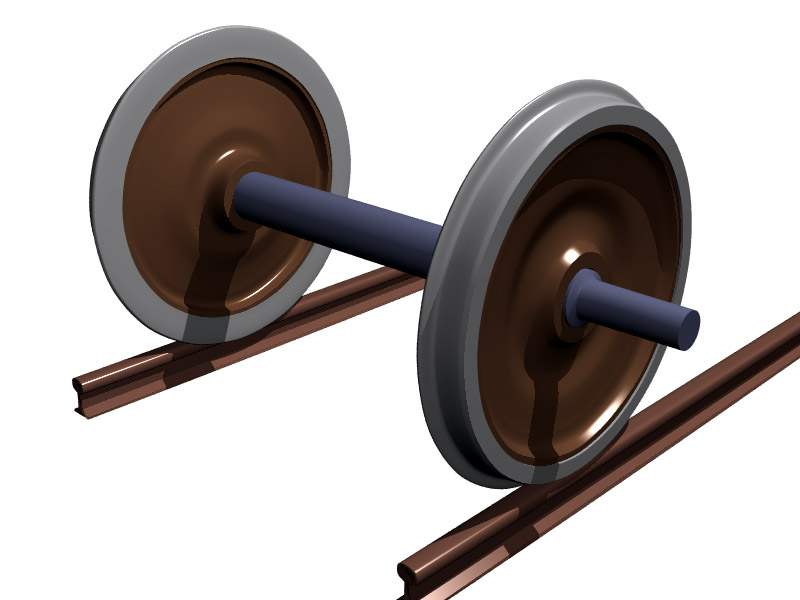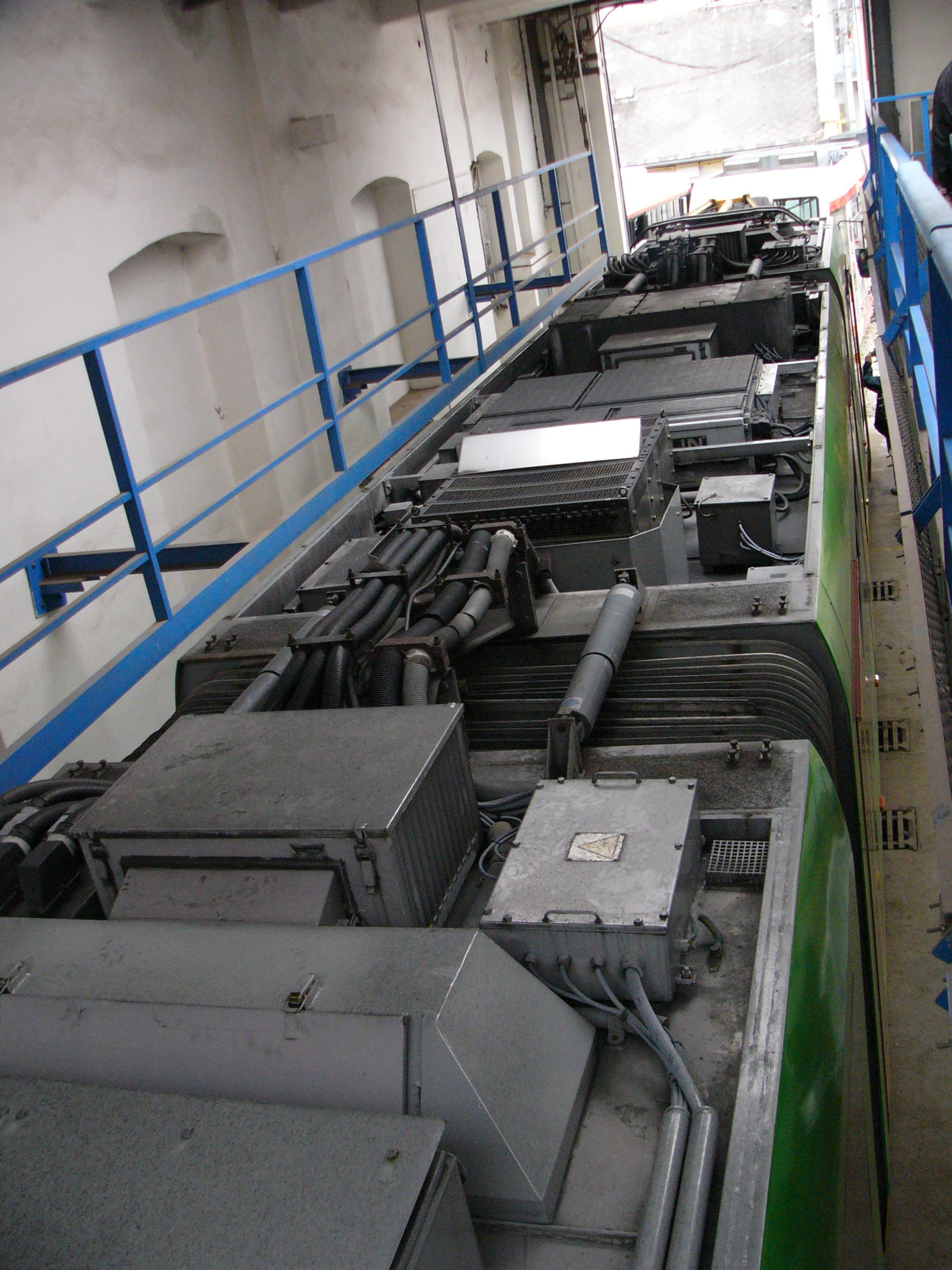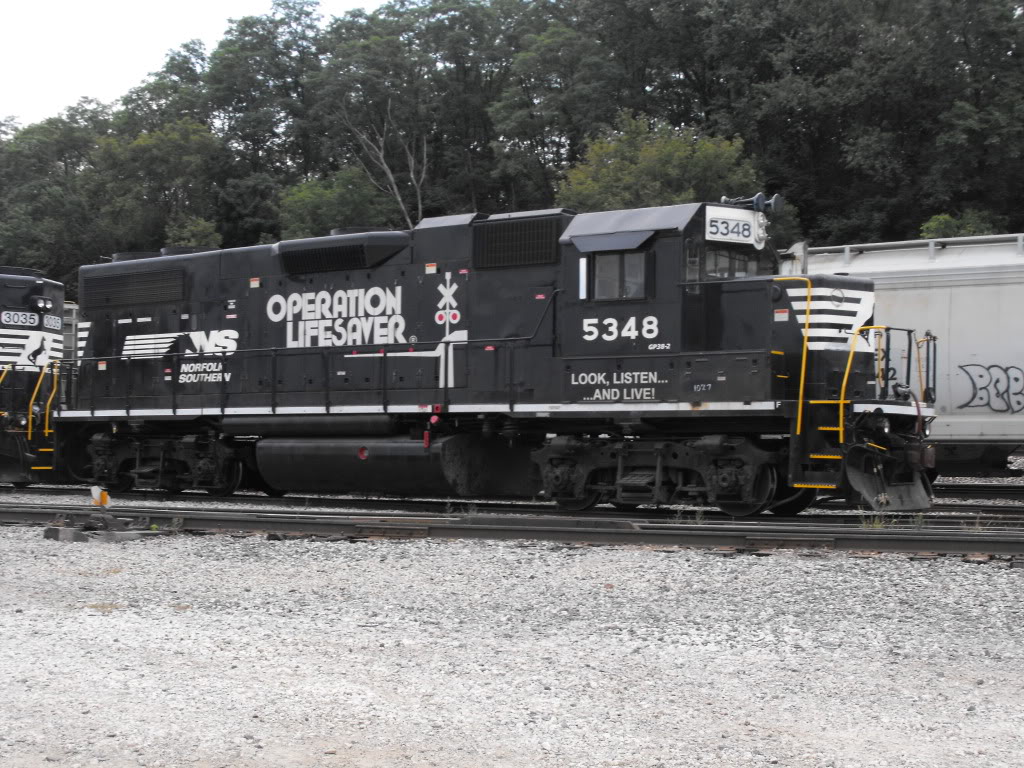|
MF 77
The MF 77 (; ) is a steel-wheeled variant of the rolling stock used on the Paris Métro. First used in 1978, it now runs on Lines 7, 8, and 13. Unlike previous models, the MF 77 was designed for travel into the immediate suburbs of Paris, and as a result has a maximum speed of which has yet to be fully utilized. In addition, it sports a new, curved silhouette with a wider midsection. Its original exterior colors, blue and white, led passengers to refer to it as ''le métro blanc'', or white metro. The MF77 trains are to be replaced between 2027-2036 by the MF 19 trains, first on Line 13 in 2027, then on Line 8 in 2029, and lastly on Line 7 in 2033. After the MF77 trains leave line 7, the entire network will be composed of trains with open gangways, automated announcements and asynchronous motors. History Replacing the Sprague In the early 1970s, upon the completion of the MF 67 delivery, at the time the newest steel-wheeled trains on the Métro, many technological ad ... [...More Info...] [...Related Items...] OR: [Wikipedia] [Google] [Baidu] |
Maison Blanche Station
Maison Blanche station () is a station of the Paris Métro, serving lines 7 and 14. South of this station, Line 7 forks into two branches, one leading to and the other to . Since June 2024, it is an interchange with Line 14 running southwards to Aéroport d'Orly. Location The line 7 station is located under Avenue d'Italie, between Rue Caillaux and Rue Bourgon, near Porte d'Italie, a gate in the former Thiers Wall. Towards the south, this is the last station on the common trunk of line 7 before the branches separate, thanks to an underground grade-separated junction located after the station, one towards ''Mairie d'Ivry'' and the other towards ''Villejuif-Louis Aragon''. Oriented approximately along a north-south axis, it is positioned between ''Tolbiac'' on the one hand and ''Porte d'Italie'' (towards Ivry) or ''Le Kremlin-Bicêtre'' (towards Villejuif) on the other. On line 14, the station is between ''Olympiades'' and ''Hôpital Bicêtre''. The line 14 station is locate ... [...More Info...] [...Related Items...] OR: [Wikipedia] [Google] [Baidu] |
MF 67
The MF 67 (; ) is a fleet of steel-wheel electric multiple unit trains for the Paris Métro. The first MF 67 trains entered service on Paris Métro Line 3, Line 3 in June 1968, and became one of the biggest orders for the Métro, with 1,482 cars constructed. The need to replace the Sprague-Thomson fleet, as well as increasing costs associated with the later-cancelled plan to introduce rubber-tyred trains on all Métro lines, were the main factors for the size of the order. At its peak, during the late-1980s and the early-1990s, the MF 67 operated on eight of the (then) fifteen Métro lines (Lines Paris Métro Line 2, 2, 3 and Paris Métro Line 3bis, 3bis, Paris Métro Line 5, 5, Paris Métro Line 7bis, 7bis, Paris Métro Line 9, 9, Paris Métro Line 10, 10 and Paris Métro Line 12, 12): the MF 67 also operated on Lines Paris Métro Line 7, 7, Paris Métro Line 8, 8 and Paris Métro Line 13, 13 (including the old Paris Métro Line 14 (1937–76), Line 14), all before the ... [...More Info...] [...Related Items...] OR: [Wikipedia] [Google] [Baidu] |
Folding Seat
A folding seat is a seat that folds away so as to occupy less space. When installed on a transit bus, it makes room for a wheelchair or two. When installed on a passenger car, it provides extra seating. In churches, it may have a projection called a misericord, which offers some support to a person standing in front when the seat is folded. Folding seats may also be found in stadiums, arenas, theaters, lecture halls and auditoriums to facilitate entry and exit. Some folding seats in rapid transit may fold-down rather than fold up. In passenger aircraft, folding seats called jump seat, are used for cabin crew during start and landing. Gallery File:1995 stock folding seats.JPG, Folding seats on the London Underground 1995 Stock File:Odakyu 3000 Folding Seat.png, Folding seat (foldaway bench) in a passenger car of the Odakyu 3000 series File:Wall chair - NÄL hospital 1.jpg, Folding seat in a corridor in NÄL hospital, Sweden File:Columbia City Cinema main hall.jpg, ... [...More Info...] [...Related Items...] OR: [Wikipedia] [Google] [Baidu] |
Plug Door
A plug door is a door designed to seal itself by taking advantage of pressure difference on its two sides and is typically used on aircraft with cabin pressurization. The higher pressure on one side forces the usually wedge-shaped door into its socket to create a seal, which prevents it from being opened until the pressure is equalised on both sides. A non-plug door relies on the strength of the locking mechanism to keep the door shut. Aircraft Plug doors are often used on aircraft with pressurized cabins because this design of door provides a simple and reliable means of securing the door and preventing leakage of air. As the air pressure outside becomes increasingly lower than that inside the cabin, the pressure difference causes the door to seal itself closed and prevent leakage. The region of the fuselage around the opening for the door must be reinforced and this adds weight, so for large doors an alternative to the plug design is commonly used. On some aircraft, a com ... [...More Info...] [...Related Items...] OR: [Wikipedia] [Google] [Baidu] |
Train Wheel
A train wheel or rail wheel is a type of wheel specially designed for use on railway tracks. The wheel acts as a rolling component, typically press fitted on to an axle and mounted directly on a railway carriage or locomotive, or indirectly on a bogie () or truck (). The powered wheels under the locomotive are called driving wheels. Wheels are initially cast or forged and then heat-treated to have a specific hardness. New wheels are machined using a lathe to a standardised shape, called a profile. All wheel profiles are regularly checked to ensure proper interaction between the wheel and the rail. Incorrectly profiled wheels and worn wheels can increase rolling resistance, reduce energy efficiency and may even cause a derailment. The International Union of Railways has defined a standard wheel diameter of , although smaller sizes are used in some rapid transit railway systems and on ro-ro carriages. Wheel geometry and flange The running surface ("tread" or "rim ... [...More Info...] [...Related Items...] OR: [Wikipedia] [Google] [Baidu] |
Cast Steel
Steel casting is a specialized form of casting involving various types of steel cast to either final/net or near-net shape. Steel castings are used when iron castings cannot deliver enough strength or shock resistance.Oberg, p. 1332 Examples of items that are steel castings include: hydroelectric turbine wheels, forging presses, gears, railroad truck frames, valve bodies, pump casings, mining machinery, marine equipment, turbocharger turbines and engine cylinder blocks. Steel castings are categorized into two general groups: carbon steels and alloy steels. Steel castability Steel is more difficult to cast than iron. It has a higher melting point and greater shrinkage rate, which requires consideration during mold design. Risers should be given more capacity to draw from as the metal cools and shrinks. Attention should be paid to the thickness of mold cavities, as thinner areas will cool quicker than thicker areas, which can create internal stress points that can lead ... [...More Info...] [...Related Items...] OR: [Wikipedia] [Google] [Baidu] |
Bogie
A bogie ( ) (or truck in North American English) comprises two or more Wheelset (rail transport), wheelsets (two Railroad wheel, wheels on an axle), in a frame, attached under a vehicle by a pivot. Bogies take various forms in various modes of transport. A bogie may remain normally attached (as on many railroad cars and semi-trailers) or be quickly detachable (as for a dolly (trailer), dolly in a road train or in railway bogie exchange). It may include Suspension (vehicle), suspension components within it (as most rail and trucking bogies do), or be solid and in turn be suspended (as are most bogies of continuous track, tracked vehicles). It may be mounted on a swivel, as traditionally on a railway carriage or locomotive, additionally jointed and sprung (as in the landing gear of an airliner), or held in place by other means (centreless bogies). Although ''bogie'' is the preferred spelling and first-listed variant in various dictionaries, bogey and bogy are also used. Rail ... [...More Info...] [...Related Items...] OR: [Wikipedia] [Google] [Baidu] |
Rim (wheel)
The rim is the "outer edge of a wheel, holding the tire". It makes up the outer circular design of the wheel on which the inside edge of the tire is mounted on vehicles such as car, automobiles. For example, on a bicycle wheel the rim is a large hoop attached to the outer ends of the spokes of the wheel that holds the tire and tube. In cross-section, the rim is deep in the center and shallow at the outer edges, thus forming a "U" shape that supports the bead of the tire casing. In the 1st millennium BC, an iron rim was introduced around the wooden wheels of chariots to improve longevity on rough surfaces. Characteristics ;Design: The first pneumatic tires for bicycles were simple tubes in shape secured to the wooden outer concave surfaced circumference of the wheel by glue and air pressure pressing them against it. The surface for receiving the tube was not very secure thus causing the tires to sometimes come off the rims. Bicycle manufacturer and inventor Thomas B. Jeffery ... [...More Info...] [...Related Items...] OR: [Wikipedia] [Google] [Baidu] |
Brake Shoe
A railway brake is a type of brake used on the cars of railway trains to enable deceleration, control acceleration (downhill) or to keep them immobile when parked. While the basic principle is similar to that on road vehicle usage, operational features are more complex because of the need to control multiple linked carriages and to be effective on vehicles left without a prime mover. Clasp brakes are one type of brakes historically used on trains. Early developments In the earliest days of railways, braking technology was primitive. The first trains had brakes operative on the locomotive tender and on vehicles in the train, where "porters" or, in the United States brakemen, travelling for the purpose on those vehicles operated the brakes. Some railways fitted a special deep-noted brake whistle to locomotives to indicate to the porters the necessity to apply the brakes. All the brakes at this stage of development were applied by operation of a screw and linkage to brake bloc ... [...More Info...] [...Related Items...] OR: [Wikipedia] [Google] [Baidu] |
Railway Air Brake
A railway air brake is a railway brake power braking system with compressed air as the operating medium. Modern trains rely upon a fail-safe air brake system that is based upon a design patented by George Westinghouse on April 13, 1869. The Westinghouse Air Brake Company was subsequently organized to manufacture and sell Westinghouse's invention. In various forms, it has been nearly universally adopted. The Westinghouse system uses air pressure to charge air reservoirs (tanks) on each car. Full air pressure causes each car to release the brakes. A subsequent reduction or loss of air pressure causes each car to apply its brakes, using the compressed air stored in its reservoirs. Overview Straight air brake In the air brake's simplest form, referred to as a ''straight air system'', compressed air is directed to a ''brake cylinder'', causing its piston to apply force to mechanical linkage, which linkage is conventionally referred to as the ''brake rigging'' (see illu ... [...More Info...] [...Related Items...] OR: [Wikipedia] [Google] [Baidu] |
Regenerative Braking
Regenerative braking is an energy recovery mechanism that slows down a moving vehicle or object by converting its kinetic energy or potential energy into a form that can be either used immediately or stored until needed. Typically, regenerative brakes work by driving an electric motor in reverse to recapture energy that would otherwise be lost as heat during braking, effectively turning the traction motor into a generator. Feeding power backwards through the system like this allows the energy harvested from deceleration to resupply an energy storage solution such as a battery or a capacitor. Once stored, this power can then be later used to aid forward propulsion. Because of the electrified vehicle architecture required for such a braking system, automotive regenerative brakes are most commonly found on hybrid and electric vehicles. This method contrasts with conventional braking systems, where excess kinetic energy is converted to unwanted and wasted heat due to friction i ... [...More Info...] [...Related Items...] OR: [Wikipedia] [Google] [Baidu] |
Dynamic Brakes
Dynamic braking is the use of an electric traction motor as a Electric generator, generator when slowing a vehicle such as an electric locomotive, electric or diesel locomotive, diesel-electric locomotive. It is termed "Resistor#Adjustable resistors, rheostatic" if the generated electrical power is dissipated as heat in brake grid resistors, and "regenerative brake, regenerative" if the power is returned to the supply line. Dynamic braking reduces wear on friction-based braking components, and regeneration lowers net energy consumption. Dynamic braking may also be used on railcars with multiple units, light rail vehicles, tram, electric trams, trolleybuses, and electric automobile, electric and hybrid electric automobiles. Principle of operation Converting electrical energy to the mechanical energy of a rotating shaft (electric motor) is the inverse of converting the mechanical energy of a rotating shaft to electrical energy (electric generator). Both are accomplished through the ... [...More Info...] [...Related Items...] OR: [Wikipedia] [Google] [Baidu] |








